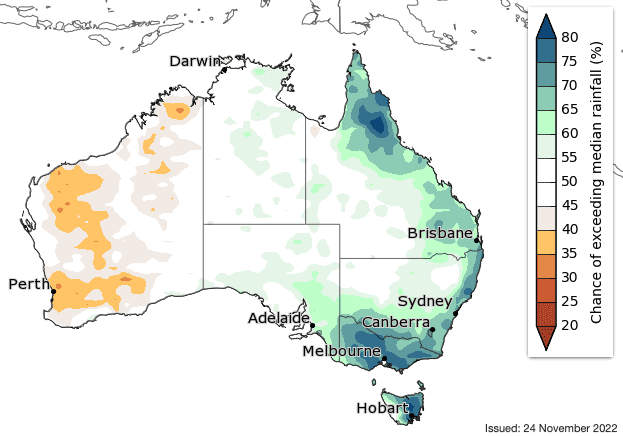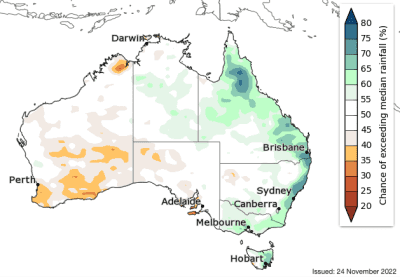December 2022 to February 2023 rainfall outlook.
IT’S likely to be wetter than usual along Australia’s east coast – particularly coastal New South Wales, most of Victoria, large areas of Queensland, and northern and eastern Tasmania, according to the Bureau of Meteorology’s long-range forecast for the Summer season.
In contrast, drier than usual conditions are more likely in large parts of Western Australia.
In eastern Australia, any significant rainfall has the potential to lead to widespread flooding where rivers are already high, dams are full, and catchments are wet.
Above-average rainfall also increases the risk of landslides and tree falls in areas of steep terrain and very wet soils.
This Summer there is a high chance that nights will be warmer than usual across the tropical north and in some southern areas including Tasmania.
Summer days are likely to be warmer than average across most of Western Australia and the Northern Territory, north and central Queensland coastal areas and parts of the south including Tasmania.
 Cooler days are likely for most of New South Wales, part of southern Queensland and into Victoria.
Cooler days are likely for most of New South Wales, part of southern Queensland and into Victoria.
Bushfires are always a risk in southern Australia in Summer. Vegetation growth after above-average rainfall can lead to a risk of grass fires. AFAC will release its Summer Bushfire Outlook on 29 November.
Ocean temperatures around northern Australia are well above average, increasing the risk of tropical cyclones and heavy rain events from systems drawing moisture from the Coral Sea.
This summer there is also an increased risk of:
- prolonged heatwaves with higher humidity in southern areas
- an above average number of tropical cyclones and tropical lows
- coastal flooding in the east and north with unusually high tides forecast around 23 January and 20 February
- marine heatwaves with warmer than average waters around Australia
- thunderstorm asthma events in the south while pollen counts are high in early summer.
A range of climate drivers around Australia are contributing to the wet outlook in the east, including a La Niña in the Pacific Ocean, a positive Southern Annular Mode and warmer ocean waters around Australia.
The negative Indian Ocean Dipole event is weakening and will likely come to an end by early Summer, while the La Niña in the Pacific Ocean may start to ease in early 2023.





HAVE YOUR SAY